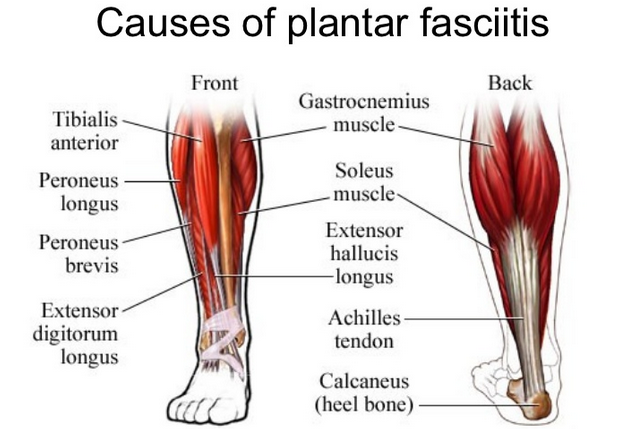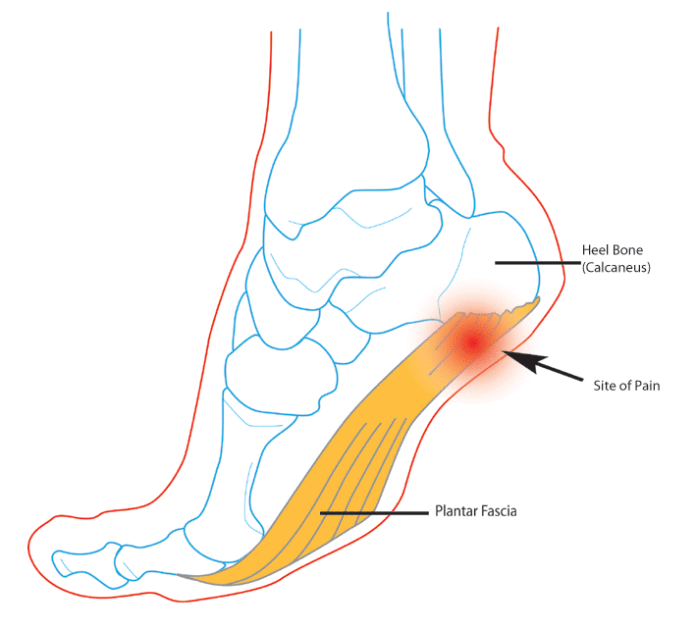
The plantar fascia is a flat band of tissue (ligament) that connects your heel bone to your toes. Under normal circumstances, your plantar fascia acts like a shock-absorbing bowstring, supporting the arch in your foot. Too much pressure on your feet over time can cause tiny tears in the ligament. The plantar fascia becomes inflamed with repetitive strain causing heel pain and stiffness, often experienced as a stabbing pain or aching in the bottom of your foot near the heel. This is known as plantar fasciitis (PLAN-ter fash-ee-EYE-tus), one of the most common causes of heel pain.
Most people with plantar fasciitis experience foot pain when they take their first steps after getting out of bed or sitting for a long time. You may have less stiffness and pain after you take a few steps, but your foot or feet may hurt more as the day goes on. It may hurt the most when you climb stairs or after standing for a long time.
Factors that may increase your risk of developing plantar fasciitis include:
-
Age. Plantar fasciitis is most common between the ages of 40 and 60.
-
Certain types of exercise. Activities which place a lot of stress on your heel and attached tissue — such as long-distance running, ballet dancing and dance aerobics — can contribute to an earlier onset of plantar fasciitis.
-
Faulty foot mechanics. Being flat-footed, having a high arch or even having an abnormal pattern of walking can adversely affect the way weight is distributed when you’re standing and put added stress on the plantar fascia.
-
Obesity. Excess pounds put extra stress on your plantar fascia.
-
Occupations that keep you on your feet. Factory workers, teachers and others who spend most of their work hours walking or standing on hard surfaces can damage their plantar fascia.
-
Pregnancy. Women who are pregnant often experience bouts of plantar fasciitis, particularly during late pregnancy.
Ignoring plantar fasciitis may result in chronic heel pain that hinders your regular activities. If you change the way you walk to minimize plantar fasciitis pain, you might also develop foot, knee, hip or back problems.
What you can do at home
-
Pain relievers such as ibuprofen (Advil, Motrin IB, others) and naproxen (Aleve) may ease the pain and inflammation associated with plantar fasciitis.
-
Give your feet a rest. Cut back on activities that make your foot or feet hurt. Try a low impact sport like swimming or bicycling.
-
Get a new pair of athletic shoes with good arch support and a cushioned sole.
-
Do toe stretches, calf stretches, and towel stretches several times a day, especially when you first get up in the morning. (For towel stretches, you pull on both ends of a rolled towel that you place under the ball of your foot.)
-
Apply ice. Hold a cloth-covered ice pack over the area of pain for 15 to 20 minutes three or four times a day or after activity.
Try ice massage. Freeze a water-filled paper cup and roll it over the site of discomfort for about five to seven minutes. Regular ice massage can help reduce pain and inflammation.
When to seek professional help
If your pain doesn’t decrease within a few weeks with home remedies, contact Paspa Physical Therapy for a consultation.
The therapists will perform a detailed evaluation and then implement a treatment program, which can include manual techniques, education, stretching and strengthening exercises.
Plantar fasciitis most often occurs because of injuries that have happened over time. While it may take time to recover completely, the right therapy for you will significantly speed recovery and help you to prevent re-injury.


















































